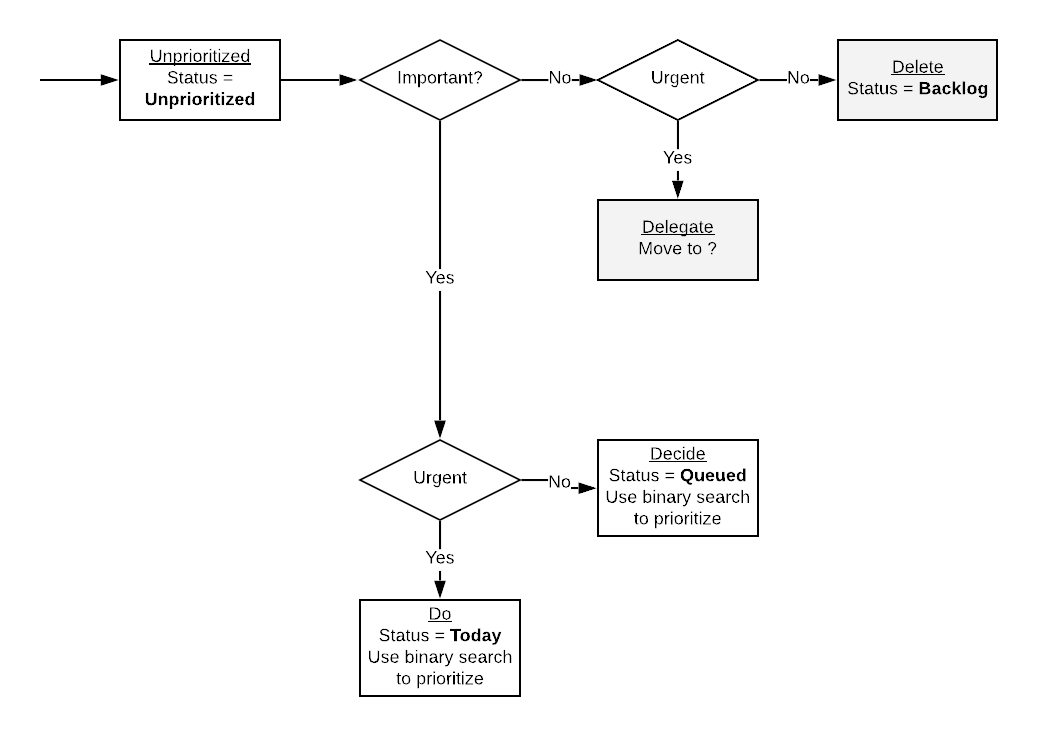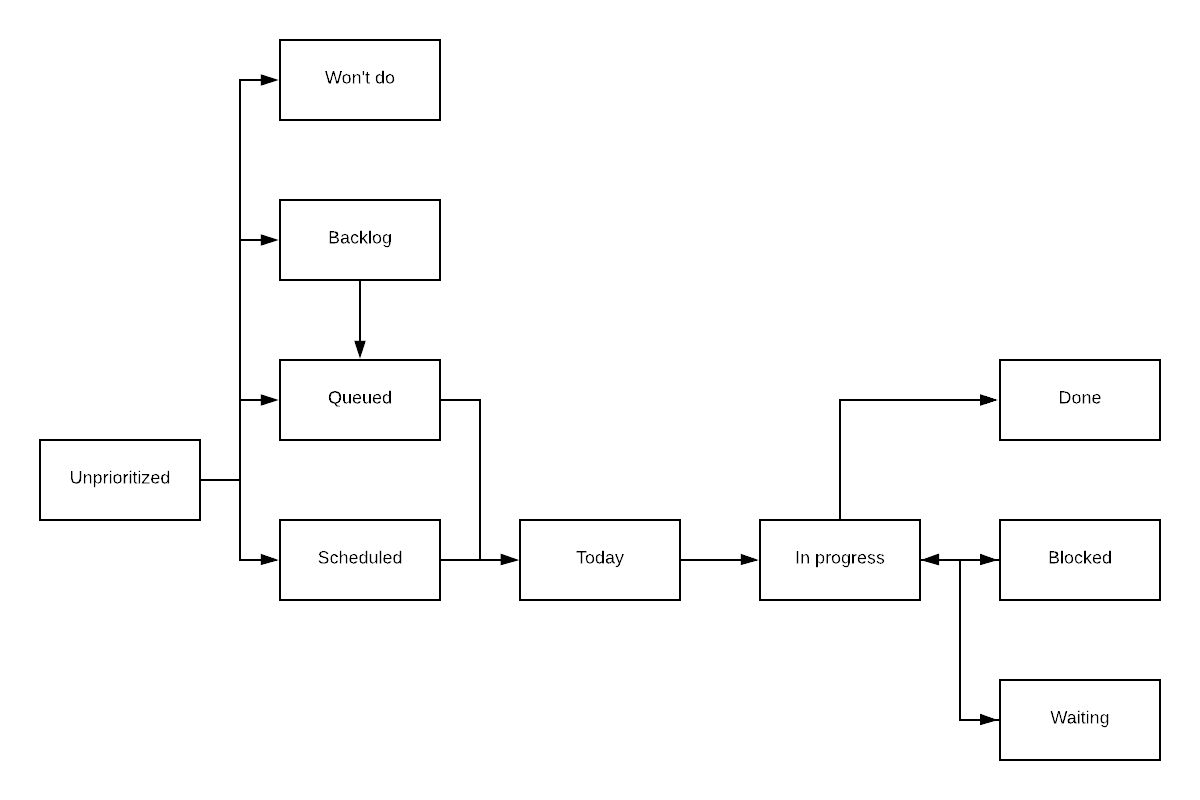- Write/prepare an agenda listing the items to be discussed
- Indicate the duration and responsible/lead of each
- Aim for a meeting to last under an hour. If more time appears to be required, then prior work should be done in order to reduce the amount of time necessary for the meeting.
- Define the list of invitees, try to keep it short, possibly under 6 people
- Share the agenda with all the attendees
- Schedule the meeting around boundaries (beginning/end of day, before/after lunch)
- Present the agenda
- Designate a person that will make sure that the agenda is respected
- Determine next actions
- Define deadlines for each next action
- Assign a responsible for each next action
- Create tasks in a task tracking system for the next actions
- In the case where a recurrent meeting needs to be scheduled at a different time than usual, specify in the body of the message the reason of the change.
- Summary
- Software version
- Reproducible in latest version?
- Environment details: compiler/interpreter, operating system, etc.
- Steps to reproduce
- Expected results
- Actual results
- Screen capture (if relevant)
- Give it a title
- Decide if it's important or not
- Decide if it's urgent or not
- Estimate the effort required to accomplish the task (in hours)
- Estimate the value the task brings (in $)
- Give it at least one label
- Give it an assignee
- Give a description if necessary
- Set a deadline if possible
- Set status to Unprioritized (ideally automatically/default)
- Indicate who requested the task
- Indicate which users/how many users would be affected by the task


Unprioritized: New task are created as unprioritized, so as to avoid having to put them in a state immediately when creating them.Won't do: A task that ends up not being relevant or useful will not be acted further upon and set to "Won't do".Backlog: A task that is not of priority at the moment but something that would be worthwhile to do at some point in the future (although maybe never due to other priorities).Queue: A task with a priority that is not high enough to be done immediately but that should be done in the near future.Scheduled: A task that has been scheduled to be done by a specific date.Today: A task that is scheduled to be done today. Tasks picked from the queue are moved to today.In progress: Tasks that are were in progress yesterday but aren't blocked, waiting, or done are moved back to today, the queue, or the backlog.Blocked: A task that is blocked by something else. The task should be moved back to today when it is unblocked.Waiting: A task that is waiting for something to happen before it can be worked on. The task should be moved back to today when it is unblocked. The difference between a blocked task and a waiting task is that a blocked task is blocked by something that is not under your control, while a waiting task is blocked by something that is under your control.Done: A task that has been completed and does not require further action.
- Go through the tasks in the Do section, then the Decide section, then Delegate
Use Eisenhower matrix to determine task importance/urgency
- Tasks that are not important/not urgent are moved to the backlog.
- Tasks that are not important/urgent are delegated to someone else.
- Tasks that are important/not urgent should be scheduled.
- Tasks that are important/urgent should be done ASAP.
Using the estimated effort and estimated value of a task, you can compute the return on investment (ROI) of the task as estimated value divided by estimated effort.
For example, a task you estimate is worth 100 $ and takes 2 hours to complete will have a ROI of 50 \$/h.
Use the ROI of your tasks to prioritize them. You will want to complete the tasks which are likely to have the best return on investment.
The ROI metric will also give you clues about the task you should probably not spend your time on. If you are paid 50 $/h and a task has a ROI less than 50 \$/h, then it should probably be moved to the backlog and only reconsidered if its ROI changes.
Unprioritizedtasks should be moved toQueued, given their priority compared to already queued tasks.- You should attempt to keep the
Unprioritizedtasks count to 0. - A task that is
Queuedshould have a deadline date. - Work on tasks
In progressfirst, then take tasks fromToday, then fromQueued. - When moving a task to
BlockedorWaiting, add a comment indicating why it is blocked/waiting and what needs to happen for it to be unblocked.

If you've never done task management before, I suggest you do not start by applying all the above at once.
First, start by simply recording the tasks you need to get done (title only).
Once you've recorded most of the tasks you have to deal with, start giving them an important/urgent assignation.
It will help you rapidly determine which tasks should be done and which ones are nice to have, but not critical, or even not really useful if you think about it.
Once you are able to have this information for most of your tasks, then you should start giving them effort and value estimates.
Once you've reached this point, you will have a much better grasp on the importance of your tasks, as well as their potential impact in terms of value, as well as to the amount of effort it will require from you.
Title(string): a high level description of the task in one sentence.Labels: a set of short identifiers relevant to the task.Status: the status of the task (see Statuses above).Assignee: who is assigned to complete the task.Important: is it important or not?Urgent: is it urgent or not?Estimated effort: effort to complete the task (in hours).Estimated value: estimated value of completing the task (in $).Description: a long description of what the task is about, possibly containing more context and a TODO list.Deadline: a time by which the task should be done or may result in the task losing value or causing issues.Who requested: the person who requested the task to be completed.Who is impacted: the people that will be impacted by the completion of the task.
- Tasks should not remain in the
In progressstate for extended periods of time. After approximately a week in that state, I would suggest re-evaluating whether this task is stillIn progressor should be moved back into theBacklog,Queued,ScheduledorTodaystate. The same should apply to theWaitingandBlockedstates.
The most up to date version of this process is available as a Claude command in my dot-claude repository.
- Verify that the build/tests pass
- Read the issue title and description
- New code
- Understand the feature and associated requirements that are supposed to be implemented
- Verify code implements the desired feature and that the requirements are completed
- New/Changed code
- Check code contains tests
- Is all the new code covered by those tests?
- Verify the location of new/moved files
- Are the files in the right directory?
- Are they appropriately named?
- Verify classes, methods, functions, parameters naming
- Are they significant of their purpose?
- Are they clear enough?
- Are they respecting the naming convention?
- Does the code respect SOLID?
- Consider that when functions/methods signature change, code may now be backward incompatible.
- Discuss whether this is necessary
- Backward incompatible changes should be documented
- In a weak typed or type hinted language, are parameters and return of functions/methods typed?
- Are there TODOs that should be completed within this review?
- Check code for code style issues
- Check code contains tests
- Bug fix
- Verify that the fix is applied at the right location and will not "fix the symptoms, not the cause"
When reviewing
- Provide specific and actionable feedback
- Clearly mark nitpicks and optional comments
- Assume competence
- Provide rationale or context
- Consider how comments may be interpreted
- Don't criticize the person, criticize the code
- Don't use harsh language
- https://en.wikipedia.org/wiki/SOLID
- https://medium.com/palantir/code-review-best-practices-19e02780015f
- https://phauer.com/2018/code-review-guidelines/
- https://smartbear.com/learn/code-review/guide-to-code-review-process/
- https://smartbear.com/learn/code-review/best-practices-for-peer-code-review/
- https://nyu-cds.github.io/effective-code-reviews/03-checklist/
- https://google.github.io/eng-practices/
- https://testing.googleblog.com/2019/11/code-health-respectful-reviews-useful.html
- https://engineering.18f.gov/code-review/
- https://conventionalcomments.org/
- https://docs.gitlab.com/ee/development/code_review.html
- https://gitmoji.dev/
- Code changes are stored in git
- Setup continuous integration (e.g., GitHub Actions)
- Use dependency management (e.g., uv)
- Have a testing framework (e.g., pytest)
- Define a code standard, enforced through tools and not documentation (e.g., ruff)
- Prefer typed function/method over dynamic types
- On every commit to git
- Code quality check
- Code style check
- Unit/functional/integration/system tests
- Code coverage should be recorded during tests and a report made available
- Prior to pushing
- Use an LLM tool to review the changes to identify potential issues
- On pushes, the CI should
- Code quality check
- Code style check
- Unit/functional/integration/system tests
- A project repository must have
- a
README.mdexplaining how to run the project on your own computer - a
RELEASING.mdexplaining how to release the code - a
CHANGELOG.mdlisting relevant changes made
- a
- Responsibilities are made explicit in terms of roles
- Critical roles, such as project lead, must have a backup/shadow individual
- Setup telemetry, alerts, profiling, logging